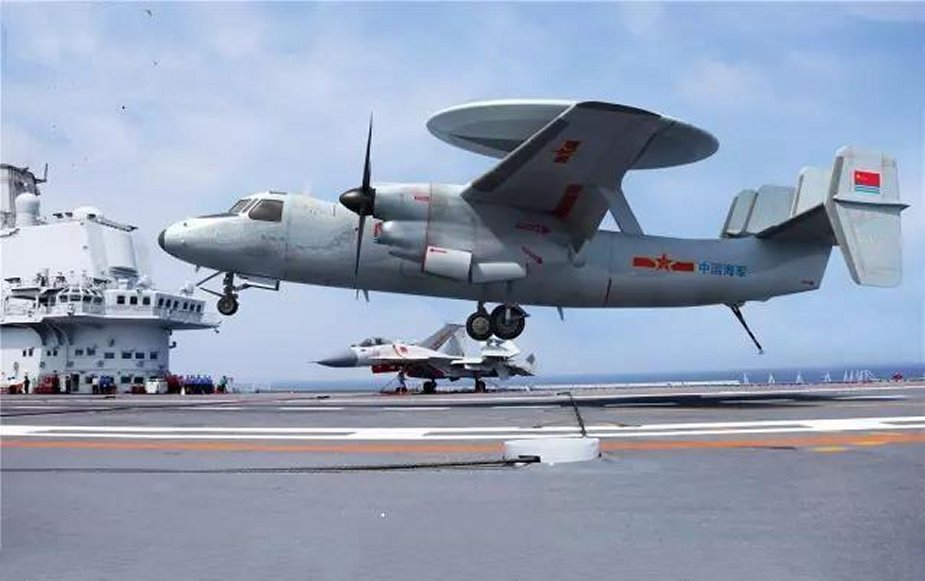As China’s naval ambitions continue to soar, the country’s third aircraft carrier, the Fujian, appears to be nearing its sea trial phase, as evidenced by recent images that are circulating online. These showcase the carrier’s deck brimming with a variety of aircraft mockups.
The visuals, shared by a pro-China military aviation researcher on X (formerly Twitter), reveal a significant development in China’s naval capabilities. The images, initially posted on April 16, depict the Fujian at Shanghai with its deck loaded with a variety of aircraft mockups.
Among the five mockups visible are fighter jets, a jet trainer, and an early warning and control aircraft. This marks the fullest deck display observed thus far for the carrier, Fujian.
The tweet highlighted the assortment of mockups, including a KJ-600 early warning and control aircraft, two J-15 fighters, the stealthy J-35 deck-based fighter, and a JL-10 jet trainer.
Thanks to @QwaSkkn2447 I missed, that there is not only the KJ-600, J-15 & J-35 but altogether 5 mock-ups including a second J-15 and the JL-10J. pic.twitter.com/cLIQim5iKO
— @Rupprecht_A (@RupprechtDeino) April 16, 2024
These visuals appear to have been taken from an overhead perspective, possibly by a passenger in a plane flying past the vessel. Also, the markings on the deck, including taxi guidelines, parking areas, and take-off and landing indicators, suggest the completion of drafting work on Fujian’s deck.
Of particular interest among the array of aircraft mockups is the inclusion of the JL-10 jet trainer, placed in the center of the deck. This appears to mark the trainer’s first sighting on the Fujian carrier, hinting at its potential deployment aboard the vessel.
Earlier, in March 2024, an image surfaced depicting the unfinished JL-10J jet trainer mockup positioned adjacent to the Fujian carrier. The carrier-capable variant of the JL-10, the JL-10J, is anticipated to join the Fujian’s arsenal, further enhancing its operational capabilities.
Additionally, the imagery highlights the presence of two Shenyang J-15 fighter mockups on deck, positioned at either end. While the J-15 mockups have been observed on Fujian earlier, their consistent presence underscores their significance in the carrier’s operations.
The J-15T, a catapult-equipped variant of the J-15, is expected to become a key aircraft on the Fujian, complementing the People’s Liberation Army Navy’s existing carrier fleet, which operates the standard J-15.
The inclusion of diverse aircraft mockups on the Fujian carrier signifies a crucial phase in the vessel’s preparation for sea trials.
By simulating real-world scenarios with these mockups, the People’s Liberation Army Navy (PLAN) is aiming to gain invaluable insights into the operational dynamics of its aircraft carriers, paving the way for enhanced capabilities in future deployments.
China’s Aircraft Carrier Fujian’s Air Wing
Named Type 003, the Chinese aircraft carrier Fujian was ceremoniously launched in June 2022 and is currently undergoing final preparations at the Jiangnan shipyard in Shanghai.
Diverging from its predecessors, it adopts a catapult-assisted takeoff but arrested recovery (CATOBAR) system and features an advanced electromagnetic aircraft launch system (EMALS).
The aircraft carrier represents a significant addition to the Chinese Navy’s arsenal, with the latest images providing a tantalizing glimpse into the future air wing of this catapult-equipped vessel.
One key component of Fujian’s air wing is expected to be the stealthy J-35, which represents the next generation of carrier-based fighter capability for the PLAN.
The aircraft, derived from the earlier FC-31 developed by Shenyang Aircraft Corporation (SAC), made its maiden flight on October 29, 2021.
While the exact number of flying prototypes remains unclear, recent imagery from Chinese social media suggests the presence of two flying prototypes or pre-production airframes.
The J-35’s inclusion in Fujian’s air wing signals a shift towards modernization — complementing and eventually replacing the J-15. Mockups of the J-35 began appearing on the Fujian in November 2023, indicating the carrier’s readiness to accommodate this new generation fighter.
Further, the appearance of another J-35 mockup on the carrier Liaoning in February 2024 suggests the PLAN’s intention to operate this advanced fighter from both existing short takeoff but arrested recovery (STOBAR) carriers and new catapult-equipped hulls.
This move aligns with the PLAN’s objective to phase out the Russian-legacy J-15 across all carriers, ensuring uniformity and enhanced capabilities across its fleet.
In addition to the J-35, the Fujian’s air wing is expected to feature the KJ-600 carrier-based airborne early-warning (AEW) aircraft, which will play a crucial role in airborne surveillance and aerial battle management.

Developed by the Xi’an Aircraft Company, the KJ-600 resembles the US Navy’s E-2 Hawkeye, equipped with a large radar above the fuselage and capable of carrying a crew of four to six.
The introduction of the KJ-600 will represent a major advance for Chinese carrier aviation, providing critical airborne surveillance capabilities previously unavailable.
It remains uncertain whether China plans to develop a cargo variant of the KJ-600 for carrier onboard delivery (COD) roles, akin to the US Navy’s C-2 Greyhound.
In addition to the mentioned aircraft, the J-15 will also play a significant role, representing the current carrier-borne fighter capability of the PLAN.
Already operational on both the Liaoning and Shandong carriers, the Chinese Navy boasts a fleet of approximately 70 or more such airframes, catering to the needs of the two STOBAR carriers and facilitating land-based training requirements.
Beyond its original STOBAR-fighter variant, the J-15 has undergone further development. This evolution includes the introduction of a two-seater version for training purposes, known as the J-15S, as well as a variant optimized for electronic warfare, named the J-15D.
Nonetheless, these developments showcase the J-15 platform’s adaptability and versatility in fulfilling various roles within the PLAN’s carrier aviation operations. Meanwhile, information regarding the potential deployment of the JL-10J jet trainer is limited at the moment.
- Contact the author at ashishmichel(at)gmail.com
- Follow EurAsian Times on Google News